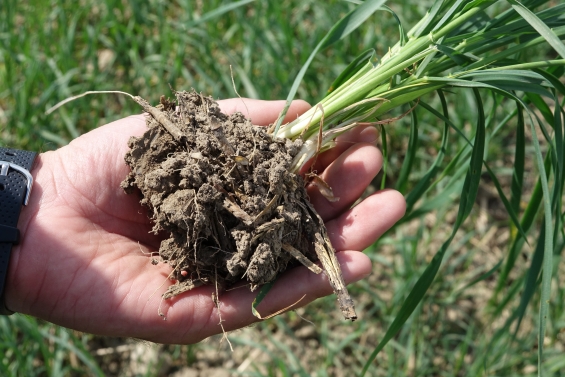In this simple chain the priority goes to the first item. By following mankind’s needs there was a need to intensify agricultural output, therefore it is not a surprise as the soil loose its fertility. This problem has been solved differently by using various agricultural systems and introducing organic and mineral fertilisers. However, sooner or later the question – what is the main reason behind the soil fertility – have risen. This question was answered by the practical experience and later scientific tests, which revealed that soil fertility is closely related with the humus content in it. In practice humus provides the soil with a colour, therefore the more hummus means the darker soil colour, that is also more fertile.
Humic materials (lot. humus – ground) was firstly extracted from the peat by German scientist F.Achard in 1786 and for more that 200 years scientists have been researching them. They are the the substances which origins are related to biochemical degradation of vegetative micro and macro fauna. They form in the soil and consist of humic, fulvic acids, their acids – humates and fulvates; other humic and fulvic acid composites with soil minerals.
Organic composites’ turn into humic acids is called humification process. This process can take place not only under the presence of live microorganisms, but also under chemical oxidation, hydrolysis, condensation and other processes. Differently from genetically coded processes in the live cell, humification does not have a strict program, which means that various compositions can be created: both simpler or more complicated to initial bio cell. Newly made composites start to participate in new shyntezis or splitting reactions – this process is practically continuous. Due to many reactions stable, long term composites tend to form in live organisms, where short term and unstable in not live organisms.
Humic materials form specific dark colour molecular groups, that appear in the soil during organic materials’ deconstruction period. Humic acids of soil, peat and coal have 4 times of fixed carbon comparing to non fixed carbon in all plants and animals on the planet. Although, humic acids cannot be named as the processes’ waste materials. They are naturals and most important plant and mineral material composites formed during evolution.
Humic acids perform many functions. One of the – accumulation (accumulate chemical elements and energy that is essential for live organisms). It means that humic acids are responsible for the liveliness of soil biota. Humic materials remain unchanged for thousand years and maintain a long term supply of energy and nutrients. Humic materials release nutrients gradually at the same maintaining their reserves. In this way humic materials are different to mineral composites, which are able to provide nutrients, but they are in easily soluble forms and plants use them rapidly or they are washed away from the soil.
Another important humic materials’ function – regulation. Humic acids take part in soil structure and water regime formation and regulation. They maintain ion exchange reaction between solid and liquid particles, are responsible for oxidation restoration reactions, regulate soil and atmosphere warmth regime (by increasing it artificially – greenhouse effect is created).
Humic materials also provide protective functions. They are able to bind not very agile toxic and radioactive composites. Their protective function is so strong that humic soils do not let pass lead or other toxic composite ions to the ground waters.
Physiological humic substances function – stimulate seed germination, activate plant breathing, increase animal productivity, etc. It has been noted that humic materials increase organisms’ protection against inflammatory processes. Humic materials tend to change the penetration of cell membranes, increase ferments’ activity, stimulate plant breathing, participate in proteins and carbohydrates’ synthesis. As a result, by using humic substances it is possible to grow ecological agricultural products.
The combination of already mentioned functions maintain outdoor plants’ productivity and production quality. Scientists highlight positive effects on plants under unfavourable growing conditions: low or high temperatures, drought, accumulation of chemicals or radionuclides. In modern agricultural situation when intensive agriculture takes place it is essential to maintain humic substances’ concentration in the soil.
It is hard to name all the function of humic substances, although already mentioned ones are more than enough to say that they are important in increasing soils’ fertility and protecting biosphere.

